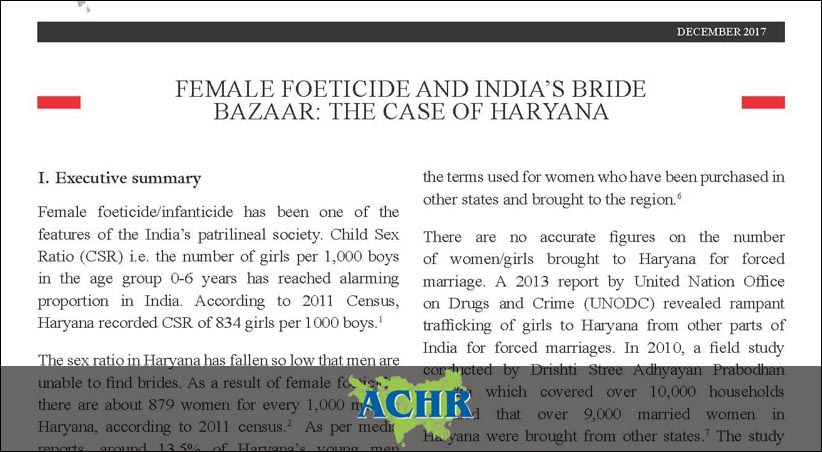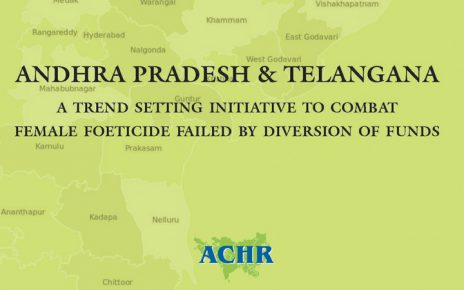Female foeticide/infanticide has been one of the features of the India’s patrilineal society. Child Sex Ratio (CSR) i.e. the number of girls per 1,000 boys in the age group 0-6 years has reached alarming proportion in India. According to 2011 Census, Haryana recorded CSR of 834 girls per 1000 boys.
The sex ratio in Haryana has fallen so low that men are unable to find brides. As a result of female foeticide, there are about 879 women for every 1,000 men in Haryana, according to 2011 census. As per media reports, around 13.5% of Haryana’s young men between the age group of 25 and 29 were unmarried in 2010, primarily due to lack of brides. Unmarried men in Jind district (which had 871 females per 1,000 males) had formed “Jind Kunwara Union” (Jind Bachelors Union) and demanded “brides” in lieu of their votes ahead of the Parliamentary elections of 2014.
The scarcity of women has given risen to trafficking with Haryana becoming epicenter of India’s bride bazaar. Thousands of women/girls from poor families in states such as Assam, West Bengal, Bihar, Tripura, Odisha, Jharkhand, Uttar Pradesh, etc. have been either brought or bought for marriage purposes in Haryana. The women/girls who are sold off as brides against their will are known in Haryana as ‘paros’ or ‘molki’ (molki literally means ‘one who has a price’), the terms used for women who have been purchased in other states and brought to the region.
There are no accurate figures on the number of women/girls brought to Haryana for forced marriage. A 2013 report by United Nation Office on Drugs and Crime (UNODC) revealed rampant trafficking of girls to Haryana from other parts of India for forced marriages. In 2010, a field study conducted by Drishti Stree Adhyayan Prabodhan Kendra which covered over 10,000 households revealed that over 9,000 married women in Haryana were brought from other states. The study which covered 92 villages of Mahendragarh, Sirsa, Karnal, Sonepat, and Mewat districts stated that there were over 50 girls in every village that have been bought, some of them as young as 13 years. However, according to one estimate, there were over 45,000 Paros in Haryana who were brought from Jharkhand alone.
Majority of the ‘purchased brides’ are exploited, denied basic rights, duplicated as maids, and eventually abandoned. They end up being used as sex slaves and then resold to other men. The trafficked/ kidnapped/lured women/girls are negotiated at prices depending on their age, beauty and virginity and are exploited. These women/girls are forced to get married or live in the family against their desire without performing marital ceremony. Many a times, these women have to accept polyandry, i.e. sharing of one woman among brothers.
The State Government of Haryana is aware of the same but has failed to take effective measures apart from providing lip service.
Unless a host of measures including compulsory registration of all marriages and marriage with the purchased/t rafficked woman/girls is criminalised, trafficking for the purposes of marriage as a direct consequence of female foeticide will continue unabated.
- The scale of female foeticide in Haryana
Haryana leads India in low CSR among all the States and Union Territories in India. According to 2011 Census, Haryana recorded CSR of 834 girls per 1000 boys in the age group of 0-6 years. The previous Census data indicates that the CSR of Haryana remained dismal. During 1971 census, the period prior to use of ultrasound machines for sex selections, the CSR was 898, which increased to 902 in 1981 but decreased to 819 in 2001. The CSR increased to 834 in 2011. But the CSR of Haryana is still far below the national average CSR of 919, a difference of 85 points. There are 21 districts, of which only one district namely Mewat recorded CSR above 900 in 2011. The district which recorded lowest CSR was Mahendragarh (778) followed by Jhajjar (782), Rewari (787), Sonipat (798), Ambala (810), Kurukshetra (818), Karnal (824), Yamunagar (826), Rohtak (828), Kaithal (828), Gurgaon (830), Bhiwani (832), Panipat (837), Jind (838), Faridabad (843), Fatehabad (854), Hisar (855), Sirsa (862), Panchkula (863), Palwal (866), and Mewat (906).




